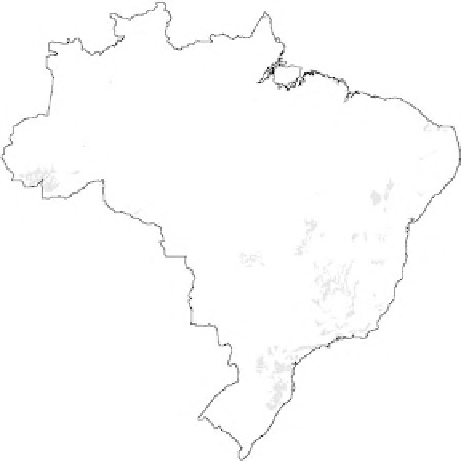Agriculture Reference
In-Depth Information
Figure 11.10
A map of Brazil showing the main distribution of Cambissolos.
Grouping of soils with a dominance of plinthite and with or without petroplin-
thite. Soils having within 40 cm of the surface a lithoplinthic or a plinthic horizon showing 15%
or more plinthite by volume or petroplinthic material that is at least 15 cm thick. The above
diagnostic characteristics may occur within a depth of 200 cm when underlying
horizons show
evidence of reduction processes and/or gleyic conditions.
This class includes mainly those soils that have been previously identiÝed as Lateritas Hidromr-
Ýcas; part of Podzlicos Plinticos, part of Glei Hmico Plintico and Glei Pouco Hmico Plintico;
and a few Latossolos Plinticos.
The geographical distribution of this soil class secluded from the 1:5,000,000 scale of the
Brazilian soil map is shown in Figure 11.11. It comprises 510,716 km
PlintossolosÐ
corresponding to 6.0% of
2
the country.
Soils lacking a chernozemic A horizon but having a nitic B or textural B horizon
with CEC of the clay fraction equal to or higher than 27 cmol
LuvissolosÐ
/kg of clay and base saturation of
50% or more. Nitic or textural B horizon may occur immediately below an albic E horizon or a
weak, a moderate, or a prominent A horizon. Plinthic and/or gley horizons, if present, occur below
the upper boundary of the B horizon or 50 cm of the surface; therefore they are not diagnostic for
Plintossolos and Gleissolos, respectively.
This class includes mainly those soils that have been previously identiÝed as Bruno No Clcico,
Podzlico Vermelho-Amarelo EutrÝco with high-activity clay, Podzlico Bruno-Acinzetado Eutr-
Ýco, and Podzlico Vermelho-Escuro EutrÝco with high-activity clay.
The geographical distribution of this soil class secluded from the 1:5,000,000 scale of the
Brazilian soil map is shown in Figure 11.12. It comprises 178,610 km
c
corresponding to 2.7% of
2
the country.
Grouping of soils showing a rather moderate development of pedological ferral-
itization process along with kaolinitic-oxidic soil genesis. Have a textural B horizon with CEC less
than 27 cmol
ArgissolosÐ
/kg of clay. Plinthic and/or gley horizons, if present, occur below the upper boundary
of the B horizon or 50 cm of the surface, and are therefore not diagnostic for Plintossolos and
Gleissolos, respectively. They lack diagnostic characteristics of Alissolos and Planossolos.
c




















